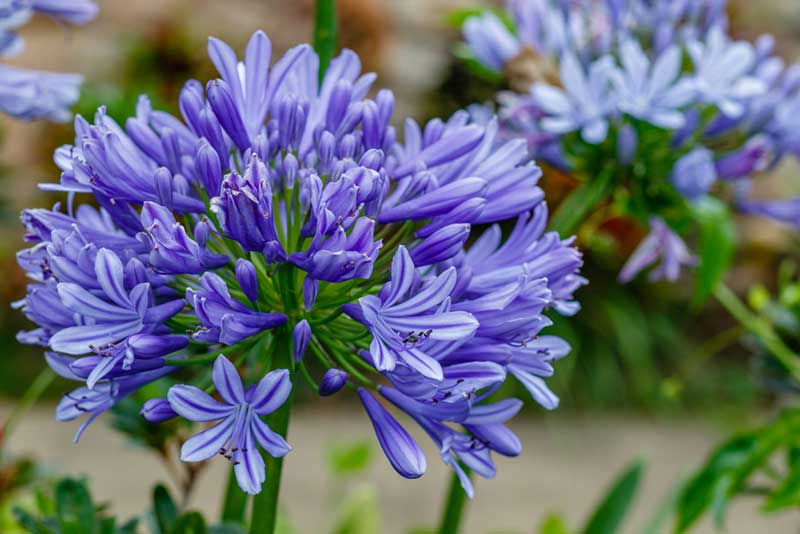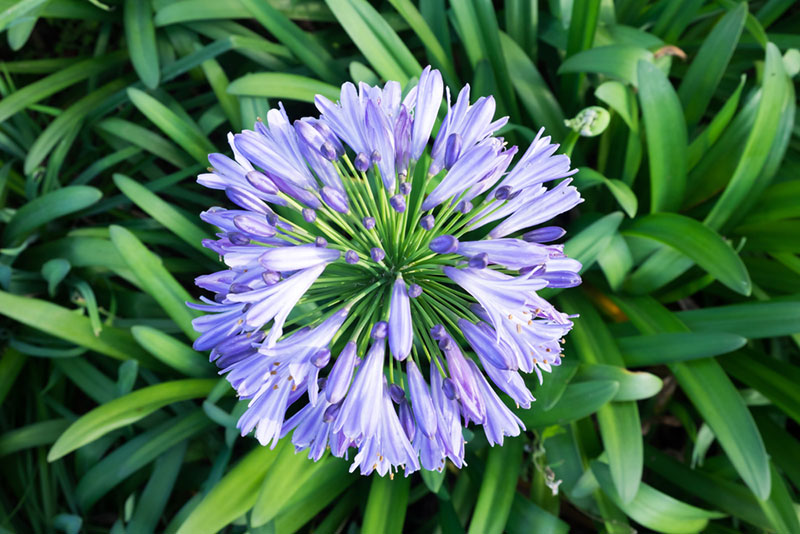
Agapanthus is a plant priced for its graceful stalks and its bright violet flowers. They are hardy in zones 6 through 11. The long blooming season means you can enjoy its purple flowers from the sprint through fall’s first frost. The flower stems of these plants can get as tall as 6′, and there are also dwarf varieties that get only 20″ tall.
Light and Temperature Requirements
This plant will tolerate both full sun and partial shade. If you live in a hotter climate, agapanthus can have some shade in the afternoon to keep it from getting too hot. The ideal temperature range is 55 to 60 degrees. Depending on the type of agapanthus, the plant may be hardy to 20 degrees and even below. In general, especially with the evergreen varieties, keep it indoors if the nights get down to 50 degrees or below. It generally needs to be kept in dimmer conditions in the winter than in the spring. If it’s indoors, keep it in a sunny room during the growing season and then move it to a darker room for the winter.
Watering
Water your agapanthus regularly in the spring, and keep watering it regularly throughout its bloom time. Water it more sparingly during the winter. Many people bring theirs indoors after the flowers have died and winter temperatures are approaching. During the winter, the plant rests and should rarely receive water.
While the plant is becoming established, it should get about 1 inch of water every week. Once it is established, about half of that amount is needed up until the winter.
When you water your agapanthus, it’s better for the plant if you use a drip irrigation method so that the soil slowly becomes moist without a lot of water getting onto the plant’s foliage. This will keep your plant at less risk for developing fungal infections.

Soil & Fertilizing
A standard potting soil that is high in peat moss is good soil for the agapanthus. It should also have good drainage and contain items like bark or sand that will let the water drain more easily. In the spring, fertilize it with a liquid fertilizer that is weak and diluted, and fertilize it regularly until it begins to flower. When the first flowers bloom, stop fertilizing it until the next spring. Using mulch on top of the soil will help keep some moisture in it for longer. You can also add compost to the soil to make it richer and more nutritious for the plant. The soil pH can be anywhere from 5.5 to 7.5.
Deadheading and Pruning
Deadhead the dead flowers once they have faded. This will make the plant look better as well as keep it from going to seed. By cutting away the dead flowers as soon as they die, you can avoid having your agapanthus develop its seed pods. If you do see one or more seed pods develop, cut away the entire pod to avoid it opening and throwing seeds in every direction. This keeps the agapanthus healthier and more vigorous, and it also keeps them from invading the rest of your garden and/or indoor plants.
If your plant goes dormant in the late fall, leave the leaves on it until they have completely died and turned brown. This allows the plant to keep sending energy down to its rhizomes to be stored for the winter. Then, cut the leaves away completely. New foliage will grow back in the spring.





